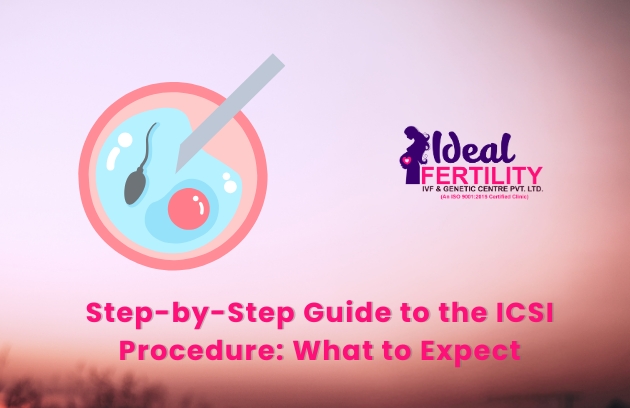Table of Contents
Intracytoplasmic Sperm Injection (ICSI) is a highly advanced form of assisted reproductive technology (ART) that has revolutionized infertility treatments. Designed to address severe male infertility and other reproductive challenges, ICSI fertility treatment involves injecting a single sperm directly into an egg to facilitate fertilization.
This procedure, often performed as part of ICSI IVF, offers hope to couples who have struggled to conceive. In this guide, we’ll walk you through the ICSI procedure step by step, giving you a clear understanding of what to expect.
What is ICSI and When is it Recommended?
ICSI is a specialized procedure used in conjunction with IVF (In Vitro Fertilization). Unlike traditional IVF, where sperm fertilize the egg in a petri dish, ICSI involves the manual insertion of a single sperm into the egg using a fine needle.
When is ICSI Recommended?
- Severe male infertility (low sperm count or poor motility).
- Unexplained infertility.
- Previous failed IVF cycles.
- Poor egg fertilization in traditional IVF.
- Need for sperm retrieval procedures like testicular biopsy.
If you’re searching for ICSI treatment near me, choosing a reputable ICSI clinic with experienced specialists is crucial for optimal results.
Step-by-Step Guide to the ICSI Procedure
Step 1: Initial Consultation and Assessment
Before starting the ICSI cycle, both partners undergo a thorough evaluation.
- Male Assessment: Includes semen analysis to determine sperm quality and quantity.
- Female Assessment: Involves blood tests to check hormone levels and an ultrasound to evaluate ovarian reserve.
At this stage, your doctor will explain the ICSI treatment process, potential outcomes, and associated costs, such as ICSI treatment cost and ICSI IVF cost, to help you plan accordingly.
Step 2: Ovarian Stimulation
The female partner undergoes ovarian stimulation to produce multiple eggs. This involves:
- Hormonal Medications: Injectable hormones like FSH and LH stimulate the ovaries.
- Monitoring: Regular ultrasounds and blood tests track follicle development.
Ovarian stimulation ensures that multiple mature eggs are available for fertilization, increasing the chances of success.
Step 3: Egg Retrieval
Once the follicles have matured, a procedure called egg retrieval is performed.
- Trigger Injection: An hCG shot is administered to trigger ovulation.
- Egg Collection: Using ultrasound guidance, eggs are collected from the ovaries via a needle. This is a minimally invasive procedure performed under sedation.
The retrieved eggs are carefully stored in a laboratory to prepare for the next step.
Step 4: Sperm Collection and Preparation
The male partner provides a sperm sample on the day of egg retrieval. If natural sperm collection is not possible, methods like testicular biopsy are used.
- Sperm Preparation: The sperm sample is processed to isolate the healthiest and most motile sperm for the ICSI procedure.
This step is particularly beneficial for patients with severe male infertility, a common reason for opting for ICSI fertility treatment.
Step 5: Fertilization via ICSI
Here’s where the magic happens. Using a high-powered microscope and fine instruments:
- A single sperm is selected and injected directly into the egg’s cytoplasm.
- The fertilized eggs are monitored for cell division, indicating successful fertilization.
This level of precision makes ICSI an effective option, even in cases of severe infertility.

Step 6: Embryo Development and Culture
The fertilized eggs (now embryos) are cultured in a controlled lab environment for 3-5 days.
- Embryo Grading: Embryologists assess the quality of embryos to select the best one for transfer.
- Any remaining high-quality embryos can be frozen for future use.
The careful monitoring during this phase ensures only the healthiest embryos are used, improving the success rates of ICSI fertility treatment.
Step 7: Embryo Transfer
The final step in the ICSI procedure step by step is transferring the selected embryo into the uterus.
- Procedure: Using a thin catheter, the embryo is placed in the uterine lining. This is a painless and quick process.
- Luteal Support: Hormonal medications like progesterone are prescribed to support implantation and early pregnancy.
The patient is advised to rest and avoid strenuous activities during the two-week wait for a pregnancy test.
Benefits of ICSI Treatment
ICSI IVF offers several advantages, making it one of the most sought-after fertility treatments:
- High Fertilization Rate: By directly injecting sperm into the egg, ICSI bypasses many barriers to fertilization.
- Overcomes Severe Male Infertility: Even men with very few or non-motile sperm can father a child with ICSI.
- Better Outcomes for Previous IVF Failures: Couples who have experienced failed IVF cycles often find success with ICSI.
- Enables Genetic Testing: Embryos created via ICSI can be tested for genetic conditions before implantation, ensuring a healthier pregnancy.
ICSI Treatment Costs
The ICSI treatment cost can vary based on factors like clinic location, doctor expertise, and additional procedures like embryo freezing or genetic testing. While ICSI cost is generally higher than traditional IVF, its success rates and benefits make it a worthwhile investment for many couples.
For an accurate estimate, consult an ICSI clinic near you. Many clinics offer packages that combine IVF and ICSI, providing more affordable options for patients.
What to Consider When Choosing an ICSI Clinic
Selecting the right clinic is vital for the success of your treatment. Look for:
- Experienced Specialists: Choose a clinic with a track record in performing ICSI fertility treatment.
- Advanced Technology: Ensure the clinic has state-of-the-art lab facilities for egg retrieval and embryo culture.
- Transparent Pricing: Verify the breakdown of costs, including ICSI IVF cost and additional charges.
- Convenience: Look for clinics offering ICSI treatment near me for easy access to appointments and follow-ups.
Who Should Consider ICSI?
ICSI is particularly beneficial for couples dealing with:
- Severe male infertility (low sperm count or motility).
- Blocked or absent sperm ducts.
- Unexplained infertility.
- Poor egg fertilization in previous IVF cycles.
- Use of frozen eggs or embryos.
If you’re unsure whether ICSI fertility treatment is right for you, consult a fertility specialist to explore your options.
Advancements in ICSI Fertility Treatment
The field of ART is constantly evolving, and ICSI continues to benefit from technological advancements:
- Time-Lapse Imaging: Monitors embryo development in real time for better selection.
- AI-Driven Selection: Artificial intelligence is being used to predict the viability of embryos.
- Enhanced Culture Media: Provides a more supportive environment for embryos to thrive.
These innovations improve the accuracy and success rates of the ICSI procedure step by step.
Conclusion
The ICSI procedure step by step is a highly precise and effective solution for overcoming infertility. By addressing barriers to fertilization, ICSI fertility treatment has helped countless couples achieve their dream of parenthood. Understanding the process, from ovarian stimulation to embryo transfer, empowers patients to make informed decisions about their treatment.
If you’re considering this option, consult an experienced ICSI clinic to begin your journey. While the ICSI treatment cost may seem significant, the advanced techniques and personalized care make it a worthwhile investment in your future family. With the right support, ICSI fertility treatment can turn your dream of having a baby into reality.


